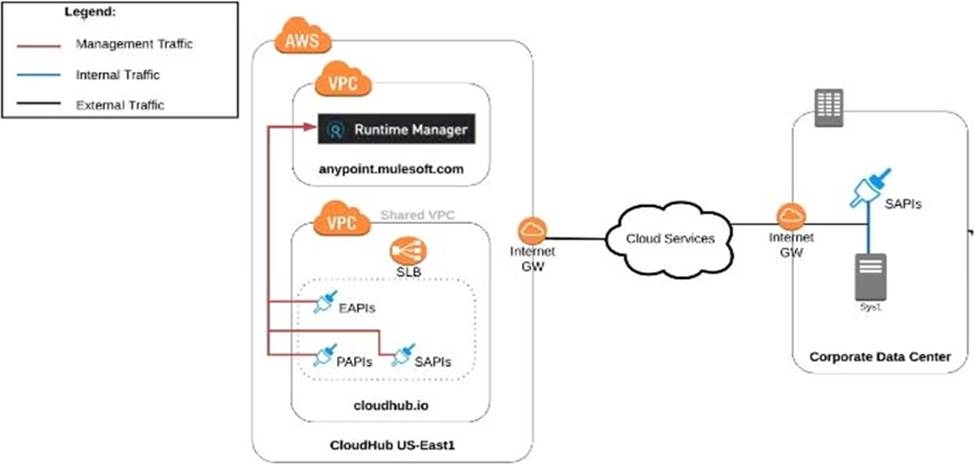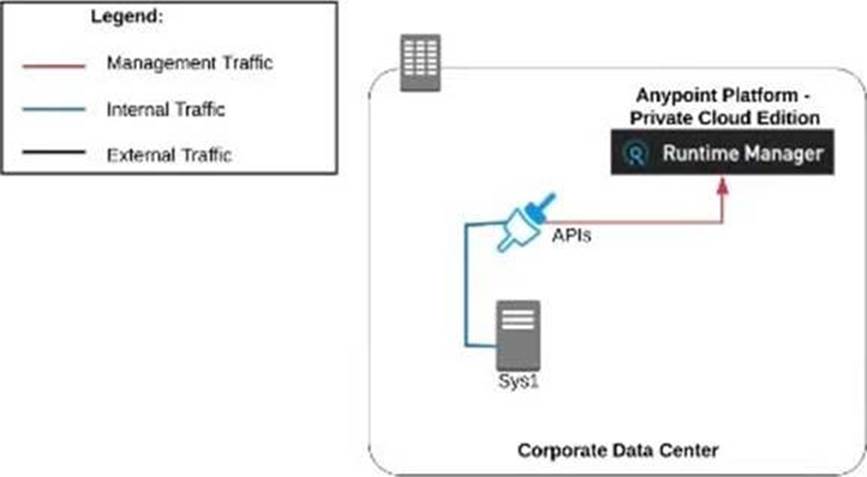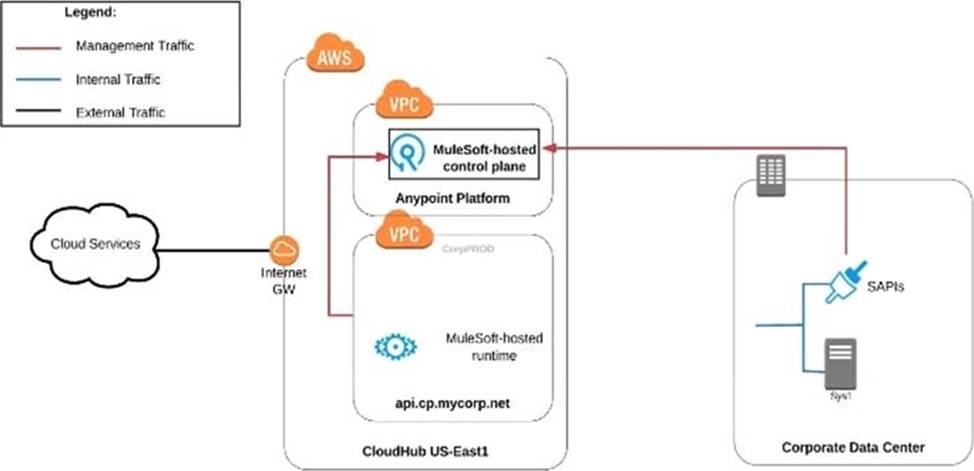Mulesoft MCPA-Level 1 exam MuleSoft Certified Platform Architect – Level 1 Online Training
Mulesoft MCPA-Level 1 exam Online Training
The questions for MCPA-Level 1 exam were last updated at Nov 19,2024.
- Exam Code: MCPA-Level 1 exam
- Exam Name: MuleSoft Certified Platform Architect - Level 1
- Certification Provider: Mulesoft
- Latest update: Nov 19,2024
A company wants to move its Mule API implementations into production as quickly as possible. To protect access to all Mule application data and metadata, the company requires that all Mule applications be deployed to the company’s customer-hosted infrastructure within the corporate firewall .
What combination of runtime plane and control plane options meets these project lifecycle goals?
- A . Manually provisioned customer-hosted runtime plane and customer-hosted control plane
- B . MuleSoft-hosted runtime plane and customer-hosted control plane
- C . Manually provisioned customer-hosted runtime plane and MuleSoft-hosted control plane
- D . iPaaS provisioned customer-hosted runtime plane and MuleSoft-hosted control plane
A
Explanation:
Explanation
Correct Answer. Manually provisioned customer-hosted runtime plane and customer-
hosted control plane
*****************************************
There are two key factors that are to be taken into consideration from the scenario given in the question.
>> Company requires both data and metadata to be resided within the corporate firewall
>> Company would like to go with customer-hosted infrastructure.
Any deployment model that is to deal with the cloud directly or indirectly (Mulesoft-hosted or Customer’s own cloud like Azure, AWS) will have to share atleast the metadata. Application data can be controlled inside firewall by having Mule Runtimes on customer hosted runtime plane. But if we go with Mulsoft-hosted/ Cloud-based control plane, the control plane required atleast some minimum level of metadata to be sent outside the corporate firewall.
As the customer requirement is pretty clear about the data and metadata both to be within the corporate firewall, even though customer wants to move to production as quickly as possible, unfortunately due to the nature of their security requirements, they have no other option but to go with manually provisioned customer-hosted runtime plane and customer-hosted control plane.
What is a best practice when building System APIs?
- A . Document the API using an easily consumable asset like a RAML definition
- B . Model all API resources and methods to closely mimic the operations of the backend system
- C . Build an Enterprise Data Model (Canonical Data Model) for each backend system and apply it to System APIs
- D . Expose to API clients all technical details of the API implementation’s interaction wifch the backend system
B
Explanation:
Correct Answer. Model all API resources and methods to closely mimic the operations of the backend system.
*****************************************
>> There are NO fixed and straight best practices while opting data models for APIs. They are completly contextual and depends on number of factors. Based upon those factors, an enterprise can choose if they have to go with Enterprise Canonical Data Model or Bounded Context Model etc.
>> One should NEVER expose the technical details of API implementation to their API clients. Only the API interface/ RAML is exposed to API clients.
>> It is true that the RAML definitions of APIs should be as detailed as possible and should reflect most of the documentation. However, just that is NOT enough to call your API as best documented API. There should be even more documentation on Anypoint Exchange with API Notebooks etc. to make and create a developer friendly API and repository..
>> The best practice always when creating System APIs is to create their API interfaces by modeling their resources and methods to closely reflect the operations and functionalities of that backend system.
An organization uses various cloud-based SaaS systems and multiple on-premises systems. The on-premises systems are an important part of the organization’s application network and can only be accessed from within the organization’s intranet.
What is the best way to configure and use Anypoint Platform to support integrations with both the cloud-based SaaS systems and on-premises systems?
A) Use CloudHub-deployed Mule runtimes in an Anypoint VPC managed by Anypoint Platform Private Cloud Edition control plane

B) Use CloudHub-deployed Mule runtimes in the shared worker cloud managed by the MuleSoft-hosted Anypoint Platform control plane

C) Use an on-premises installation of Mule runtimes that are completely isolated with NO external network access, managed by the Anypoint Platform Private Cloud Edition control plane

D) Use a combination of Cloud Hub-deployed and manually provisioned on-premises Mule runtimes managed by the MuleSoft-hosted Anypoint Platform control plane

- A . Option A
- B . Option B
- C . Option C
- D . Option D
B
Explanation:
Correct Answer. Use a combination of CloudHub-deployed and manually provisioned on-premises Mule runtimes managed by the MuleSoft-hosted Platform control plane.
*****************************************
Key details to be taken from the given scenario:
>> Organization uses BOTH cloud-based and on-premises systems
>> On-premises systems can only be accessed from within the organization’s intranet Let us evaluate the given choices based on above key details:
>> CloudHub-deployed Mule runtimes can ONLY be controlled using MuleSoft-hosted
control plane. We CANNOT use Private Cloud Edition’s control plane to control CloudHub Mule Runtimes. So, option suggesting this is INVALID
>> Using CloudHub-deployed Mule runtimes in the shared worker cloud managed by the MuleSoft-hosted Anypoint Platform is completely IRRELEVANT to given scenario and silly choice. So, option suggesting this is INVALID
>> Using an on-premises installation of Mule runtimes that are completely isolated with NO external network access, managed by the Anypoint Platform Private Cloud Edition control
plane would work for On-premises integrations. However, with NO external access, integrations cannot be done to SaaS-based apps. Moreover CloudHub-hosted apps are best-fit for integrating with SaaS-based applications. So, option suggesting this is BEST WAY.
The best way to configure and use Anypoint Platform to support these mixed/hybrid integrations is to use a combination of CloudHub-deployed and manually provisioned on-premises Mule runtimes managed by the MuleSoft-hosted Platform control plane.
An organization has implemented a Customer Address API to retrieve customer address information. This API has been deployed to multiple environments and has been configured to enforce client IDs everywhere.
A developer is writing a client application to allow a user to update their address. The developer has found the Customer Address API in Anypoint Exchange and wants to use it in their client application.
What step of gaining access to the API can be performed automatically by Anypoint Platform?
- A . Approve the client application request for the chosen SLA tier
- B . Request access to the appropriate API Instances deployed to multiple environments using the client application’s credentials
- C . Modify the client application to call the API using the client application’s credentials
- D . Create a new application in Anypoint Exchange for requesting access to the API
A
Explanation:
Correct Answer. Approve the client application request for the chosen SLA tier
*****************************************
>> Only approving the client application request for the chosen SLA tier can be automated
>> Rest of the provided options are not valid
Reference: https://docs.mulesoft.com/api-manager/2.x/defining-sla-tiers#defining-a-tier
What is a key requirement when using an external Identity Provider for Client Management in Anypoint Platform?
- A . Single sign-on is required to sign in to Anypoint Platform
- B . The application network must include System APIs that interact with the Identity Provider
- C . To invoke OAuth 2.0-protected APIs managed by Anypoint Platform, API clients must submit access tokens issued by that same Identity Provider
- D . APIs managed by Anypoint Platform must be protected by SAML 2.0 policies
C
Explanation:
https://www.folkstalk.com/2019/11/mulesoft-integration-and-platform.html
Correct Answer. To invoke OAuth 2.0-protected APIs managed by Anypoint Platform, API clients must submit access tokens issued by that same Identity Provider
*****************************************
>> It is NOT necessary that single sign-on is required to sign in to Anypoint Platform because we are using an external Identity Provider for Client Management
>> It is NOT necessary that all APIs managed by Anypoint Platform must be protected by SAML 2.0 policies because we are using an external Identity Provider for Client Management
>> Not TRUE that the application network must include System APIs that interact with the Identity Provider because we are using an external Identity Provider for Client Management Only TRUE statement in the given options is – "To invoke OAuth 2.0-protected APIs managed by Anypoint Platform, API clients must submit access tokens issued by that same Identity Provider"
References:
https://docs.mulesoft.com/api-manager/2.x/external-oauth-2.0-token-validation-policy https://blogs.mulesoft.com/dev/api-dev/api-security-ways-to-authenticate-and-authorize/
Which of the following best fits the definition of API-led connectivity?
- A . API-led connectivity is not just an architecture or technology but also a way to organize people and processes for efficient IT delivery in the organization
- B . API-led connectivity is a 3-layered architecture covering Experience, Process and System layers
- C . API-led connectivity is a technology which enabled us to implement Experience, Process and System layer based APIs
A
Explanation:
Correct Answer. API-led connectivity is not just an architecture or technology but also a way to organize people and processes for efficient IT delivery in the organization.
*****************************************
Reference: https://blogs.mulesoft.com/dev/api-dev/what-is-api-led-connectivity/
An organization wants MuleSoft-hosted runtime plane features (such as HTTP load balancing, zero downtime, and horizontal and vertical scaling) in its Azure environment .
What runtime plane minimizes the organization’s effort to achieve these features?
- A . Anypoint Runtime Fabric
- B . Anypoint Platform for Pivotal Cloud Foundry
- C . CloudHub
- D . A hybrid combination of customer-hosted and MuleSoft-hosted Mule runtimes
A
Explanation:
Correct Answer. Anypoint Runtime Fabric
*****************************************
>> When a customer is already having an Azure environment, It is not at all an ideal approach to go with hybrid model having some M
t-hosted Runtime plane and is on AWS. We cannot customize to point CloudHub to customerule Runtimes hosted on Azure and some on MuleSoft. This is unnecessary and useless.
>> CloudHub is a Mulesof’s Azure environment.
>> Anypoint Platform for Pivotal Cloud Foundry is specifically for infrastructure provided by Pivotal Cloud Foundry
>> Anypoint Runtime Fabric is right answer as it is a container service that automates the deployment and orchestration of Mule applications and API gateways. Runtime Fabric runs within a customer-managed infrastructure on AWS, Azure, virtual machines (VMs), and bare-metal servers.
-Some of the capabilities of Anypoint Runtime Fabric include:
-Isolation between applications by running a separate Mule runtime per application.
-Ability to run multiple versions of Mule runtime on the same set of resources.
-Scaling applications across multiple replicas.
-Automated application fail-over.
-Application management with Anypoint Runtime Manager.
Reference: https://docs.mulesoft.com/runtime-fabric/1.7/
What is a key performance indicator (KPI) that measures the success of a typical C4E that is immediately apparent in responses from the Anypoint Platform APIs?
- A . The number of production outage incidents reported in the last 24 hours
- B . The number of API implementations that have a publicly accessible HTTP endpoint and are being managed by Anypoint Platform
- C . The fraction of API implementations deployed manually relative to those deployed using a CI/CD tool
- D . The number of API specifications in RAML or OAS format published to Anypoint Exchange
D
Explanation:
Correct Answer. The number of API specifications in RAML or OAS format published to
Anypoint Exchange
*****************************************
>> The success of C4E always depends on their contribution to the number of reusable assets that they have helped to build and publish to Anypoint Exchange.
>> It is NOT due to any factors w.r.t # of outages, Manual vs CI/CD deployments or Publicly accessible HTTP endpoints
>> Anypoint Platform APIs helps us to quickly run and get the number of published RAML/OAS assets to Anypoint Exchange. This clearly depicts how successful a C4E team
is based on number of returned assets in the response.
Reference: https://help.mulesoft.com/s/question/0D52T00004mXSTUSA4/how-should-a-company-measure-c4e-success
An organization has created an API-led architecture that uses various API layers to integrate mobile clients with a backend system. The backend system consists of a number
of specialized components and can be accessed via a REST API. The process and experience APIs share the same bounded-context model that is different from the backend data model .
What additional canonical models, bounded-context models, or anti-corruption layers are best added to this architecture to help process data consumed from the backend system?
- A . Create a bounded-context model for every layer and overlap them when the boundary contexts overlap, letting API developers know about the differences between upstream and downstream data models
- B . Create a canonical model that combines the backend and API-led models to simplify and unify data models, and minimize data transformations.
- C . Create a bounded-context model for the system layer to closely match the backend data model, and add an anti-corruption layer to let the different bounded contexts cooperate across the system and process layers
- D . Create an anti-corruption layer for every API to perform transformation for every data model to match each other, and let data simply travel between APIs to avoid the complexity and overhead of building canonical models
C
Explanation:
Correct Answer. Create a bounded-context model for the system layer to closely match the backend data model, and add an anti-corruption layer to let the different bounded contexts cooperate across the system and process layers
*****************************************
>> Canonical models are not an option here as the organization has already put in efforts and created bounded-context models for Experience and Process APIs.
>> Anti-corruption layers for ALL APIs is unnecessary and invalid because it is mentioned that experience and process APIs share same bounded-context model. It is just the System layer APIs that need to choose their approach now.
>> So, having an anti-corruption layer just between the process and system layers will work well. Also to speed up the approach, system APIs can mimic the backend system data model.
What is true about automating interactions with Anypoint Platform using tools such as Anypoint Platform REST APIs, Anypoint CU, or the Mule Maven plugin?
- A . Access to Anypoint Platform APIs and Anypoint CU can be controlled separately through the roles and permissions in Anypoint Platform, so that specific users can get access to Anypoint CLI white others get access to the platform APIs
- B . Anypoint Platform APIs can ONLY automate interactions with CloudHub, while the Mule Maven plugin is required for deployment to customer-hosted Mule runtimes
- C . By default, the Anypoint CLI and Mule Maven plugin are NOT included in the Mule runtime, so are NOT available to be used by deployed Mule applications
- D . API policies can be applied to the Anypoint Platform APIs so that ONLY certain LOBs have access to specific functions
C
Explanation:
Correct Answer. By default, the Anypoint CLI and Mule Maven plugin are NOT included in the Mule runtime, so are NOT available to be used by deployed Mule applications *****************************************
>> We CANNOT apply API policies to the Anypoint Platform APIs like we can do on our custom written API instances. So, option suggesting this is FALSE.
>> Anypoint Platform APIs can be used for automating interactions with both CloudHub and customer-hosted Mule runtimes. Not JUST the CloudHub. So, option opposing this is FALSE.
>> Mule Maven plugin is NOT mandatory for deployment to customer-hosted Mule runtimes. It just helps your CI/CD to have smoother automation. But not a compulsory requirement to deploy. So, option opposing this is FALSE.
>> We DO NOT have any such special roles and permissions on the platform to separately control access for some users to have Anypoint CLI and others to have Anypoint Platform APIs. With proper general roles/permissions (API Owner, Cloudhub Admin etc..), one can use any of the options (Anypoint CLI or Platform APIs). So, option suggesting this is
FALSE.
Only TRUE statement given in the choices is that – Anypoint CLI and Mule Maven plugin are NOT included in the Mule runtime, so are NOT available to be used by deployed Mule applications.
Maven is part of Studio or you can use other Maven installation for development. CLI is convenience only. It is one of many ways how to install app to the runtime.
These are definitely NOT part of anything except your process of deployment or automation.
Latest MCPA-Level 1 exam Dumps Valid Version with 58 Q&As
Latest And Valid Q&A | Instant Download | Once Fail, Full Refund


OPTIONS is not cacheable, POST is, so I would go for B in the 30 question:
https://developer.mozilla.org/en-US/docs/Web/HTTP/Methods/OPTIONS
https://developer.mozilla.org/en-US/docs/Web/HTTP/Methods/POST